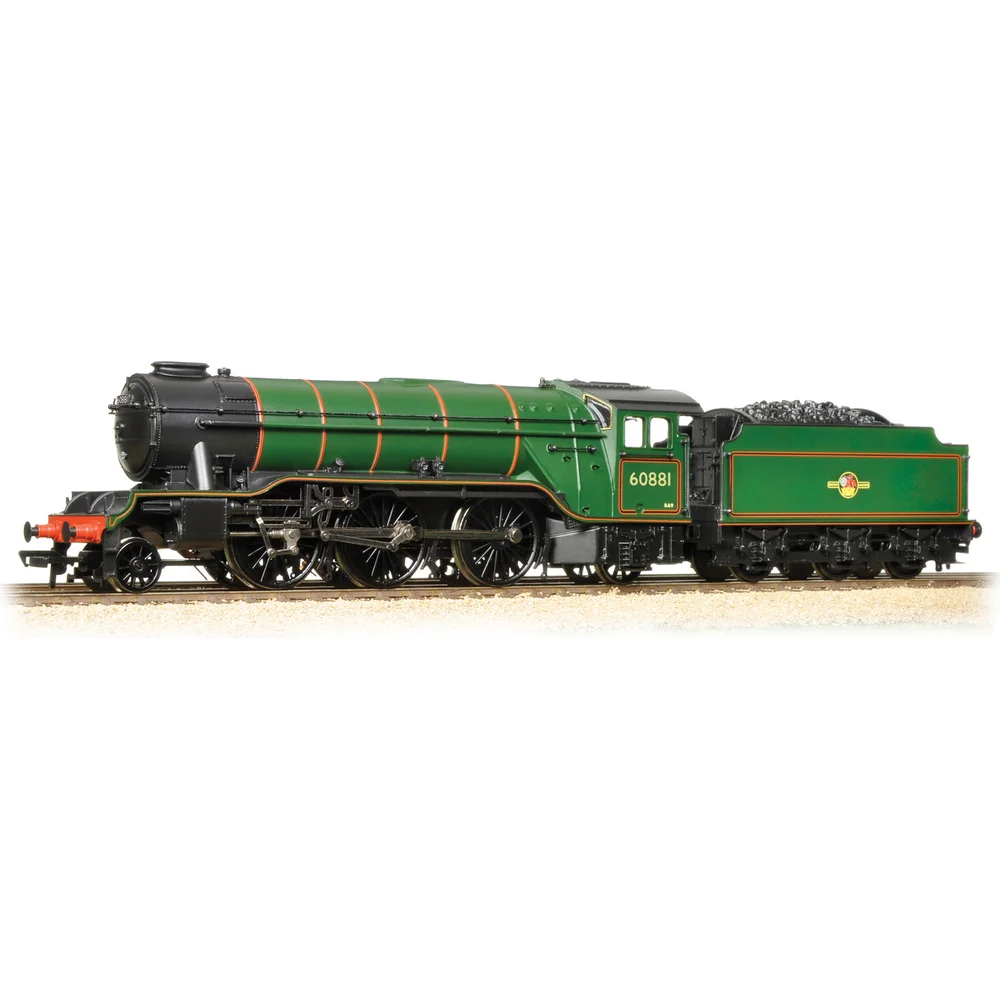Bachmann 31-567
London & North Eastern Railway V2 60881 British Railways Lined Green with Late Crest
Tooling
In 2012, Bachmann Branchline introduced a major upgrade to its OO gauge model of the LNER Class V2, replacing the original 1992 split-chassis tooling. This retooling aimed to deliver improved accuracy, reliability, and modern features such as DCC readiness, addressing long-standing criticisms of the earlier design. The V2, designed by Sir Nigel Gresley, was a mixed-traffic locomotive built between 1936 and 1944, and remains an iconic subject for British railway modellers.
Tooling Features
- Scale: OO gauge (1:76).
- Construction: Precision-moulded plastic bodyshell with a die-cast chassis for strength and weight.
- Detailing: Improved body proportions, separately fitted handrails, finer valve gear, detailed cab interior with glazing, and accurate tender variations.
- Couplings: NEM pockets with tension-lock couplers, replacing the fixed couplers of the earlier tooling.
Mechanical & Electrical
- Motor & Drive: Smooth-running can motor mounted in the chassis, driving the coupled wheels via a reliable gear train.
- Minimum Radius: Recommended for second radius curves (approx. 438 mm).
- Lighting: No factory lighting provided.
- Weighting: Die-cast chassis and internal metal components for improved traction.
DCC Capability
- DCC Ready with an 8-pin socket located in the tender.
- Space provided for a speaker to allow sound installation by the modeller.
Liveries Produced
The 2012 tooling was released in several authentic schemes, including:
- LNER Lined Green (Doncaster style)
- LNER Black
- BR Lined Black (early emblem)
- BR Green (late crest)
- Special editions such as preserved No. 4771 “Green Arrow”
Reviews & Commentary
At launch, the 2012 V2 was welcomed for its improved mechanism and DCC readiness compared to the split-chassis predecessor. However, some enthusiasts noted shortcomings in body shape accuracy, particularly around the firebox and smokebox, and commented on the relatively light weight affecting haulage. Online discussions and blogs highlighted that additional ballast could improve performance. Despite these criticisms, the model was considered a significant step forward and remained popular until the full retooling in 2021.
Interesting Notes
- The 2012 upgrade introduced a fixed Cartazzi rear axle design, improving stability over curves.
- Enthusiasts often added lead weight to enhance traction, a common modification discussed in forums.
Class & Prototype
- Class: London & North Eastern Railway V2
- Traction: Steam
- Built: 1936-1944
- Total Built: 184
- Running Number: 60881
Operator & Livery
- Operator: British Railways
- Livery: Lined Green with Late Crest
- Era: 5 - British Railways Late Crest
British Railways transformed Britain's fragmented rail network into a unified national system following nationalisation on 1st January 1948. Created from the "Big Four" companies under the Transport Act 1947, BR operated most of Great Britain's railways until rebranding as British Rail in 1965, managing over 20,000 route miles and inheriting nearly 20,000 locomotives of diverse designs.
The organisation pioneered standardisation through its revolutionary BR Standard locomotive programme (1951-1960), producing 999 advanced steam engines under Robert Riddles' direction. These included the versatile Britannia Pacifics, mighty 9F freight engines, and mixed-traffic classes that incorporated the best features from all predecessor companies. The 1955 Modernisation Plan accelerated diesel and electric traction development, creating fascinating mixed-traction operations.
Notable achievements included establishing unified locomotive classification systems, introducing distinctive corporate liveries, and managing the complex transition from steam to modern traction. BR's six regional structure preserved operational diversity whilst enabling standardisation of practices, signalling, and rolling stock that had eluded private enterprise for over a century.
The BR era represents steam traction's final flowering alongside emerging diesel technology, creating unparalleled locomotive variety. Today, this heritage remains highly popular with railway enthusiasts through extensive preserved fleets, heritage railway operations, and comprehensive model ranges from manufacturers like Hornby, Bachmann, and Dapol, making BR subjects essential for authentic post-war British railway modelling across all scales.
British Railways' lined green livery continued for express passenger locomotives from 1956, painted in BS224 Deep Bronze Green (also known as Land Rover Deep Bronze Green) with orange and black lining, maintaining the prestigious finish for the railway's premier motive power. The livery was reserved for the most powerful express passenger classes, including Britannias, Castles, Kings, A4s, Merchant Navy Pacifics, and other premier locomotives rated for top-link express duties. From 1954 onwards, green became more widely adopted across the locomotive fleet, with some mixed-traffic engines also receiving the prestigious finish as regional freedom in livery matters increased following the 1953 Transport Act.
From mid-1956, these locomotives received the new "Lion and Crown" emblem (nicknamed the "Ferret and Dartboard"), a proper heraldic device registered with the College of Arms featuring a rampant lion emerging from a crown and holding a spoked wheel, all enclosed in a roundel with "British Railways" on bars either side. The emblem was positioned centrally on tender sides, with the heraldically correct lion facing left, though some locomotives initially received forward-facing applications during the transition period. Lettering and numbering remained in golden yellow Gill Sans Medium, maintaining the high-quality finish appropriate for express passenger duties. Regional variations in the shade of green occurred depending on which works applied the paint, the suppliers used, and the number of paint layers applied, creating subtle differences between locomotive classes and individual engines. This livery represented the final flowering of BR's steam-era corporate identity, combining technical excellence with heraldic dignity during the twilight years of express steam operations before the Rail Blue revolution of the mid-1960s.
